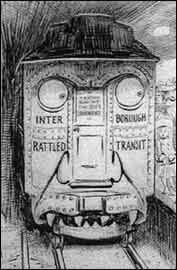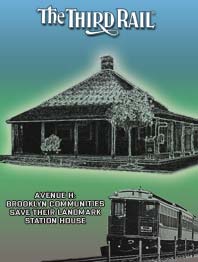
In 1919, The Brooklyn Rapid Transit company opened its massive new Coney Island Terminal to replace the individual line terminals left over from steam railroad days. Now, more than eight decades later, a beautiful new terminal has risen to replace the historic structure. This article tells the story of the "New West End Terminal" at Coney Island that recently yielded to an even more impressive structure, shown here in planning..
The Great Interborough Strike of 1919
The Brotherhood of Interborough Rapid Transit Employees, a company union, launched an amazing 100% percent effective strike against the entire IRT rapid transit system and the Manhattan els, winning a 25% across the board pay hike. The story in news clippings, researched, compiled and written by Gregory J. Christiano
Though Unification in 1940 added the big systems of the BMT and IRT to the municipally owned NYC subway system, not all the rapid transit operators in New York City came under the City umbrella.
Not included in the expanded system was New York's "forgotten" borough and the Staten Island Rapid Transit Railway Company and its 22 route miles of electric lines, which stayed with its parent Baltimore & Ohio Railroad for another 31 years. Here is its story.
Mention of rapid transit on New York's Second Avenue usally leads to a discussion of the unbuilt Second Avenue Subway. But 60 years ago New York had, and tore down, the 2nd Avenue el.
The second part of Felix E. Reifschneider's 1925 Long Island Rail Road history traces the years from the Civil War building of the South Side Railroad Line up to the Post WWI era.
The Long Island Rail Road is the nation's busist commuter railroad. Founded in 1834, it is also the nation's oldest railroad operating under its original name and charter, This is its early history.
The 1964 World's Fair provided the impetus to begin acquiring equipment for a New York City transit museum. Words and pictures describe the event and background.
Five notable events from a quarter-century ago: SOAC, the first national light rail conference, fare follies in New York City, the Culver Shuttle closes, and Dayton loses out on light rail..
A little poetry, a story about what happened when National City Lines came to Philadelphia (by S.L. Hackbridge), and a mystery vehicle for you to view.
Brooklyn's historic Franklin Avenue Shuttle reopens (by Douglas Diamond).
Sometimes the passengers had to help a little to keep the West End Line going in the old days -- like get out and walk when the train couldn't quite make it up the hill (by Morton Morris).
New York's lost transit legacy -- the BMT and its advanced car designs (by Paul Matus).
By the 1930s electric railways were everywhere in the U.S. -- and disappeared in a dramatically short time. Bradford C. Snell's study recalls the antitrust case U.S. vs. National City Lines.
A neglected piece of history recalls steam days (by Paul Matus).
The Third Rail is a registered trademark of The Composing Stack Inc.
©1999-2019 The Composing Stack Inc. All rights reserved.
Updated
The Brooklyn-Manhattan Transit Corporation's influence extended far beyond the borders of its namesake borough, New York City, or even the U.S. One outpost of its pioneering spirit was in Leningrad. In the early 1930s a delegation of Soviet traction engineers traveled to the U.S. to study the Peter Witt trolley design. The result was homage to the BMT's 6000 series cars, resulting in a fleet that dwarfed Brooklyn's, by transit professional and author James Clifford Greller..
The New York City Transit system's Avenue H station house in the community of Fiske Terrace seemed doomed when it was announced that the old wooden structure would be torn down for a modern building. The community, though, was having nothing of it, marshalling the forces of the community board, the borough president's office, the Landmarks Commission and historians to force a change in the decision to destroy the one-time real estate office turned railroad station. Here is the illustrated story of the saving of "The Little Station in the Woods," described in the September 1999 edition of The Third Rail.










